

Middle School Reading Apps and Websites. LA0953Invited. Close Reading Checklist to Use with Students in Class. January 13, 2018 Close reading is an essential survival skill specially now that we live in a data-saturated world where we are constantly bombarded by all forms of textual and non-textual stimuli.
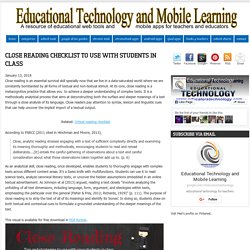
At its core, close reading is a metacognitive practice that allows you to achieve a deeper understanding of complex texts. It is a methodically analytical process that aims at deconstructing both the surface and deeper meanings of a text through a close analysis of its language. Close readers pay attention to syntax, lexicon and linguistic cues that can help uncover the implicit import of a textual output. According to PARCC (2011 cited in Hinchman and Moore, 2013), Close, analytic reading stresses engaging with a text of sufficient complexity directly and examining its meaning thoroughly and methodically, encouraging students to read and reread deliberately.... This visual is available for free download in PDF format. Text-based questions: What is the text about? EJ1071Saying. Essential Elements of Guided Reading. There are three essential elements in Guided Reading, they are before reading, during reading, and after reading.
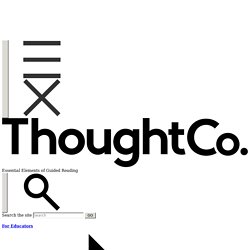
Here we will take a look at teacher and student roles during each element, along with a few activities for each, as well compare the traditional reading group with a dynamic guided reading group. Element 1: Before Reading This when the teacher introduces the text and takes the opportunity to teach students before the reading begins. Teacher's Role. Syllables and Affixes Sorts. Meet Google Drive – One place for all your files. One account.

All of Google. 13 Short Stories for Engaging Secondary Students & Teaching Literary Elements - The Literary Maven. Don't let your literature anthology dictate the short stories you read with your middle school and high school students.
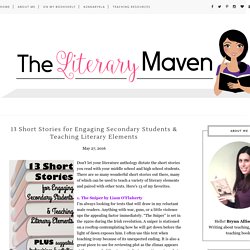
There are so many wonderful short stories out there, many of which can be used to teach a variety of literary elements and paired with other texts. Here's 13 of my favorites.1. Herro Call For Chapters. HANDOUT4 ACADEMIC WORD LIST. Developing critical reading skills with media literacy apps on Chromebooks. Frontier, an app from eSpark Learning, teaches critical thinking about media through reading and writing lessons for students in grades three through eight.

Frontier offers a library of online lessons centered on thought-provoking topics that engage all types of readers—from eager to reluctant. “It's a differentiated research, reading and writing product that allows students to have choice,” says Cindy Kopp, a fifth-grade English language arts and social studies teacher at Mineola Middle School in Mineola, NY.
Cultivating Informed Citizens with Listenwise. As concerns about fake news mount, it’s increasingly important that we expose students to high-quality news stories about current events and encourage them to think critically about those stories.
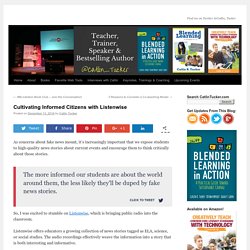
The more informed our students are about the world around them, the less likely they'll be duped by fake news stories.Click To Tweet So, I was excited to stumble on Listenwise, which is bringing public radio into the classroom. Listenwise offers educators a growing collection of news stories tagged as ELA, science, or social studies. The audio recordings effectively weave the information into a story that is both interesting and informative. The audio recordings of each news story can be played at their normal pace or slowed down for students who need it. This is an easy way to allow students to control the pace of their learning and make accommodations for second language learners. How To Read A Book: 3 Strategies For Critical Reading.
How To Read A Book: 3 Strategies For Critical Reading by Terry Heick.
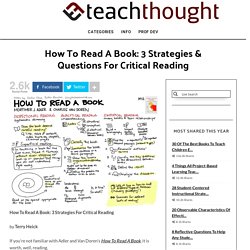
Putting a Focus on Media Literacy in the Digital Age. For K–12 students, there has never been a time in their lives when information wasn’t just a Google search away.

But does that mean that these digital natives are savvy when it comes to knowing what information to trust? The answer is overwhelmingly no, reports Stanford’s History Education Group (SHEG) in a 2016 study. “Our ‘digital natives’ may be able to flit between Facebook and Twitter while simultaneously uploading a selfie to Instagram and texting a friend,” reads the study. Fostering Difficult Conversations. Whats hot 2017 report. 7 Strategies For Using Context Clues In Reading - 7 Strategies For Using Context Clues In Reading by Kathy Glass We often ask students to use context clues to figure out a word’s meaning; therefore, it is our job to formally teach how authors use them.
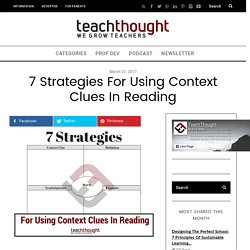
In doing so, students become armed with an inventory of ways to access unknown words to help gain deeper meaning of the text. Without awareness of the types of context clues, students are at a disadvantage to decipher meanings for themselves. Teaching this skill supports self-agency so students can define unfamiliar words independently. Poetry Across the Curriculum. April is National Poetry Month, so why not try pairing two short poems to make a mini-study of a concept, theme, structure, or perspective?
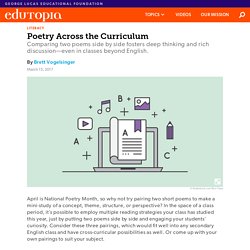
In the space of a class period, it’s possible to employ multiple reading strategies your class has studied this year, just by putting two poems side by side and engaging your students’ curiosity. Consider these three pairings, which would fit well into any secondary English class and have cross-curricular possibilities as well. Ej1026longer. Knowing the Difference Between Digital Skills and Digital Literacies, and Teaching Both. Annie Murphy Paul on Why 'Digital Literacy' Can't Replace The Traditional Kind.
Have you heard about the octopus who lives in a tree? In 2005, researchers at the University of Connecticut asked a group of seventh graders to read a website full of information about the Pacific Northwest Tree Octopus, or Octopus paxarbolis. Leu D.J. Zawilinski L. Forzani E. Timbrell N. in press. VM0194Risks. How Amy Krouse Rosenthal Inspired Malcolm Mitchell. You’ve likely seen the story. Last week in The New York Times’ “Modern Love” column, children’s book author Amy Krouse Rosenthal published an essay entitled, “You May Want to Marry My Husband.” The 51-year-old Rosenthal is fighting ovarian cancer and may not have long to live. In the essay, framed as a dating profile should her husband, Jason, soon become widowed, she describes their 26-year romance and the attributes—caring, supportive, thoughtful, adventurous, handsome, a great father—of the man with whom she has shared her life.
“The most genuine … gift I can hope for,” she writes, “is that the right person reads this, finds Jason, and another love story begins.” Rosenthal’s story went viral. Through her more than three dozen books, Rosenthal has touched and inspired countless readers. 21 Anchor Charts That Teach Reading Comprehension - WeAreTeachers. This reading blog is sponsored by Questar Assessment, a K–12 assessment-solutions provider focused on building a bridge between learning and accountability. Reading comprehension is one of the most complex skills to teach. It’s also arguably the most important. Students will only succeed in other subject areas (and make it a lifelong habit to read for pleasure) if they understand what they are reading on an ingrained level. Many factors go into the development of reading comprehension, including building an extensive vocabulary, asking questions, making connections and visualization.
Below, you’ll find 21 anchor charts that tackle some of the trickiest parts of teaching comprehension. 1. SOURCE: Life in Fifth Grade 2.